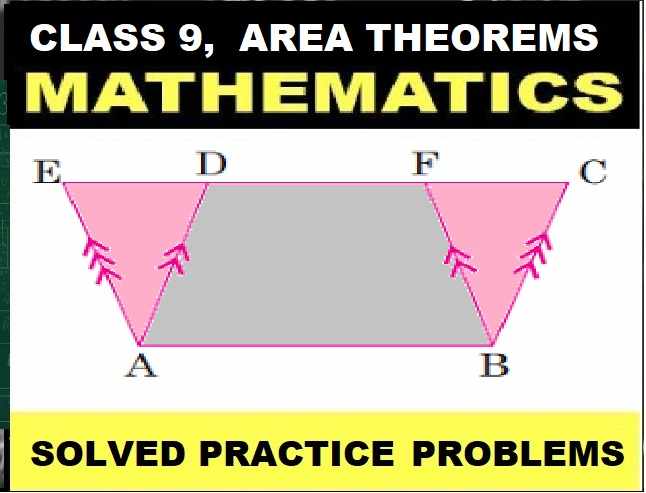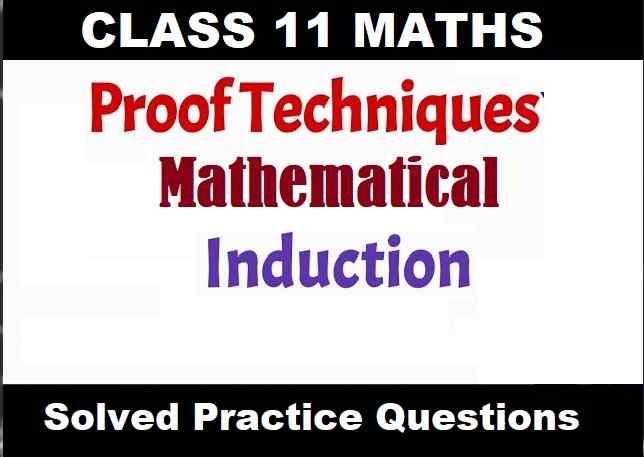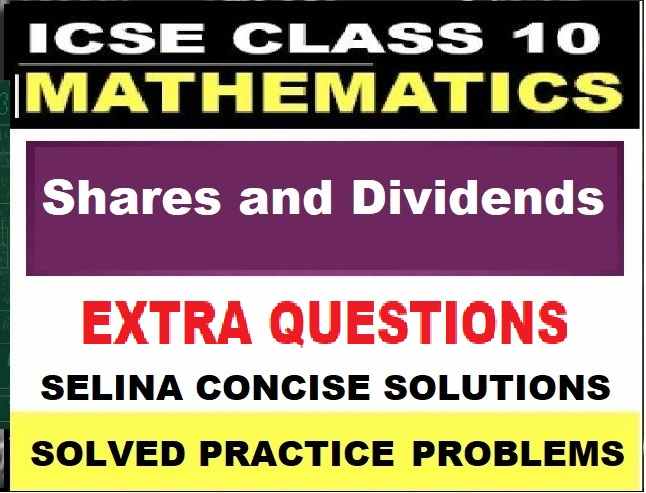ML Aggarwal Compound Interest Exe-2.3 Class 9 ICSE Maths Solutions. We Provide Step by Step Answer of Exe-Exe-2.3 Questions for Compound Interest council prescribe guideline for upcoming board exam. Visit official Website CISCE for detail information about ICSE Board Class-9.
ML Aggarwal Compound Interest Exe-2.3 Class 9 ICSE Maths Solutions
| Board | ICSE |
| Subject | Maths |
| Class | 9th |
| Chapter-2 | Compound Interest |
| Topics | Solution of Exe-2.3 Questions |
| Edition | 2024-2025 |
Compound Interest Exe-2.3
Question 1. The present population of a town is 200000. Its population increases by 10% in the first year and 15% in the second year. Find the population of the town at the end of two years.
Answer :
We know that
Population after 2 years = Present population × (1 + r/100)n
Here the present population = 200000
Population after first year = 200000 × (1 + 10/100)1
By further calculation
= 200000 × 11/10
= 220000
Population after two years = 220000 × (1 + 15/100)1
By further calculation
= 220000 × 23/20
= 253000
Question 2. The present population of a town is 15625. If the population increases at the rate of 4% every year, what will be the increase in the population in next 3 years?
Answer :
It is given that
Present population (P) = 15625
Rate of increase (r) = 4% p.a.
Period (n) = 3 years
We know that
Population after 3 years = P (1 + r/100)n
Substituting the values
= 15625 (1 + 4/100)3
By further calculation
= 15625 × 26/25 × 26/25 × 26/25
= 17576
So the increase = 17576 – 15625 = 1951
Question 3. The population of a city increase each year by 4% of what it had been at the beginning of each year. If its present population is 6760000, find:
(i) its population 2 years hence
(ii) its population 2 years ago.
Answer :
It is given that
Present population = 6760000
Increase percent = 4% p.a.
(i) We know that
Population 2 years hence = P (1 + r/100)2
Substituting the values
= 6760000 (1 + 4/100)2
By further calculation
= 6760000 × 26/25 × 26/25
= 7311616
(ii) We know that A = 6760000
Population 2 years ago P = A + (1 + r/100)2
Substituting the values
= 6760000 + (1 + 4/100)2
By further calculation
= 6760000 + (26/25)2
= 6760000 × 25/26 × 25/26
= 6250000
Question 4. The cost of a refrigerator is ₹ 9000. Its value depreciates at the rate of 5% ever year. Find the total depreciation in its value at the end of 2 years.
Answer :
It is given that
Present value (P) = ₹ 9000
Rate of depreciation (r) = 5% p.a.
Period (n) = 2 years
We know that
Value after 2 years = P (1 – r/100)n
Substituting the values
= 9000 (1 – 5/100)2
By further calculation
= 9000 × 19/20 × 19/20
= ₹ 8122.50
So the total depreciation = 9000 – 8122.50 = ₹ 877.50
Question 5. Dinesh purchased a scooter for ₹ 24000. The value of the scooter is depreciating at the rate of 5% per annum. Calculate its value after 3 years.
Answer :
It is given that
Present value of scooter (P) = ₹ 24000
Rate of depreciation (r) = 5%
Period (n) = 3 years
We know that
Value after 3 years = P (1 – r/100)n
Substituting the values
= 24000 (1 – 5/100)3
By further calculation
= 24000 × 19/20 × 19/20 × 19/20
= ₹ 20577
Question 6. A farmer increases his output of wheat in his farm every year by 8%. This year he produced 2187 quintals of wheat. What was the yearly produce of wheat two years ago?
Answer :
It is given that
Present production of wheat = 2187 quintals
Increase in production = 8% p.a.
We know that
Production of wheat 2 years ago = A ÷ (1 + r/100)n
Substituting the values
= 2187 ÷ (1 + 8/100)2
By further calculation
= 2187 ÷ (27/25)2
So we get
= 2187 × 25/27 × 25/27
= 1875 quintals
Question 7. The value of a property decreases every year at the rate of 5%. If its present value is ₹ 411540, what was its value three years ago?
Answer :
It is given that
Present value of property = ₹ 411540
Rate of decrease = 5% p.a.
We know that
Value of property 3 years ago = A ÷ (1 – r/100)n
Substituting the values
= 411540 ÷ (1 – 5/100)3
By further calculation
= 411540 ÷ (19/20)3
So we get
= 411540 × 20/19 × 20/19 × 20/19
= ₹ 480000
Question 8. Ahmed purchased an old scooter for ₹ 16000. If the cost of the scooter after 2 years depreciates to ₹ 14440, find the rate of depreciation.
Answer :
It is given that
Present value = ₹ 16000
Value after 2 years = ₹ 14440
Consider r% p.a. as the rate of depreciation
We know that
A/P = (1 – r/100)n
Substituting the values
14440/16000 = (1 – r/100)2
By further calculation
361/400 = (1 – r/100)2
(19/20)2 = (1 – r/100)2
We can write it as
1 – r/100 = 19/20
So we get
r/100 = 1 – 19/20 = 1/20
By cross multiplication
r = 1/20 × 100 = 5%
Hence, the rate of depreciation is 5%.
Question 9. A factory increased its production of cars from 80000 in the year 2011-2012 to 92610 in 2014-15. Find the annual rate of growth of production of cars.
Answer :
It is given that
Production of cars in 2011-2012 = 80000
Production of cars in 2014-2015 = 92610
Period (n) = 3 years
Consider r% as the rate of increase
We know that
A/P = (1 + r/100)n
Substituting the values
92610/80000 = (1 + r/100)3
By further calculation
(21/20)3 = (1 + r/100)3
We can write it as
1 + r/100 = 21/20
r/100 = 21/20 – 1 = 1/20
By cross multiplication
r = 1/20 × 100 = 5
Hence, the annual rate of growth of production of cars is 5% p.a.
Question 10. The value of a machine worth ₹ 500000 is depreciating at the rate of 10% every year. In how many years will its value be reduced to ₹ 364500?
Answer:
It is given that
Present value = ₹ 500000
Reduced value = ₹ 364500
Rate of depreciation = 10% p.a.
Consider n years as the period
We know that
A/P = (1 – r/100)n
Substituting the values
364500/500000 = (1 – 10/100)n
By further calculation
(9/10)n = 729/1000 = (9/10)3
So we get
n = 3
Therefore, the period in which its value be reduced to ₹ 364500 is 3 years.
Question 11. Afzal purchased an old motorbike for ₹ 16000. If the value of the motorbike after 2 years is ₹ 14440, find the rate of depreciation.
Answer :
It is given that
CP of an old motorbike = ₹ 16000
Price after 2 years = ₹ 14440
Consider r% as the rate of depreciation
We know that
A/P = (1 – r/100)n
Substituting the values
14440/16000 = (1 – r/100)2
By further calculation
361/400 = (1 – r/100)2
(19/20)2 = (1 – r/100)2
So we get
19/20 = 1 – r/100
r/100 = 1 – 19/20 = (20 – 19)/ 20 = 1/20
By cross multiplication
r = 100/20 = 5
Hence, the rate of depreciation is 5%.
Compound Interest Exe-2.3
ML Aggarwal Class 9 ICSE Maths Solutions
Page 65
Question 12. Mahindra set up a factory by investing ₹ 2500000. During the first two years, his profits were 5% and 10% respectively. If each year the profit was on previous year’s capital, calculate his total profit.
Answer :
It is given that
Investment = ₹ 2500000
Rates of profit during first two years = 5% and 10%
We know that
Capital after two years (A) = P (1 + r/100)n
Substituting the values
= 2500000 (1 + 5/100) (1 + 10/100)
By further calculation
= 2500000 × 21/20 × 11/10
= ₹ 2887500
So the net profit = A – P
Substituting the values
= 2887500 – 2500000
= ₹ 387500
Question 13. The value of a property is increasing at the rate of 25% every year. By what percent will the value of the property increase after 3 years?
Answer :
It is given that
Original price of the property (P) = ₹ 100
Rate of increase (r) = 25% p.a.
Period (n) = 3 years
We know that
Increased value after 3 years = P (1 + r/100)n
Substituting the values
= 100 (1 + 25/100)3
By further calculation
= 100 × 5/4 × 5/4 × 5/4
= ₹ 3125/16
Here
Increased value = 3125/16 – 100
Taking LCM
= (3125 – 1600)/ 16
= 1525/16
So the percent increase after 3 years = 1525/16 = 95 5/16%
Question 14. Mr. Durani bought a plot of land for ₹ 180000 and a car for ₹ 320000 at the same time. The value of the plot of land grows uniformly at the rate of 30% p.a.., while the value of the car depreciates by 20% in the first year and by 15% p.a. thereafter. If he sells the plot of land as well as the car after 3 years, what will be his profit or loss?
Answer :
It is given that
Price of plot of land = ₹ 180000
Growth rate = 30% p.a.
Period (n) = 3 years
We know that
Amount after 3 years = P (1 + R/100)n
Substituting the values
= 180000 (1 + 30/100)3
By further calculation
= 180000 × (13/10)3
It can be written as
= 180000 × 13/10 × 13/10 × 13/10
= ₹ 395460
Here
Price of car = ₹ 320000
Rate of depreciation = 20% for the first year and 15% for next period
Period (n) = 3 years
We know that
Amount after 3 years = A (1 – R1/100)n × (1 – R2/100)2
Substituting the values
= 320000 (1 – 20/100) (1 – 15/100)2
By further calculation
= 320000 × 4/5 × (17/20)2
So we get
= 320000 × 4/5 × 17/20 × 17/20
= ₹ 184960
Here
Total cost of plot and car = 180000 + 320000 = ₹ 500000
Total sale price of plot and car = 395460 + 184960 = ₹ 580420
We know that
Profit = S.P. – C.P.
Substituting the values
= 580420 – 500000
= ₹ 80420
— : End of ML Aggarwal Compound Interest Exe-2.3 Class 9 ICSE Maths Solutions :–
Return to :- ML Aggarawal Maths Solutions for ICSE Class-9
Thanks
Please Share with Your Friends


